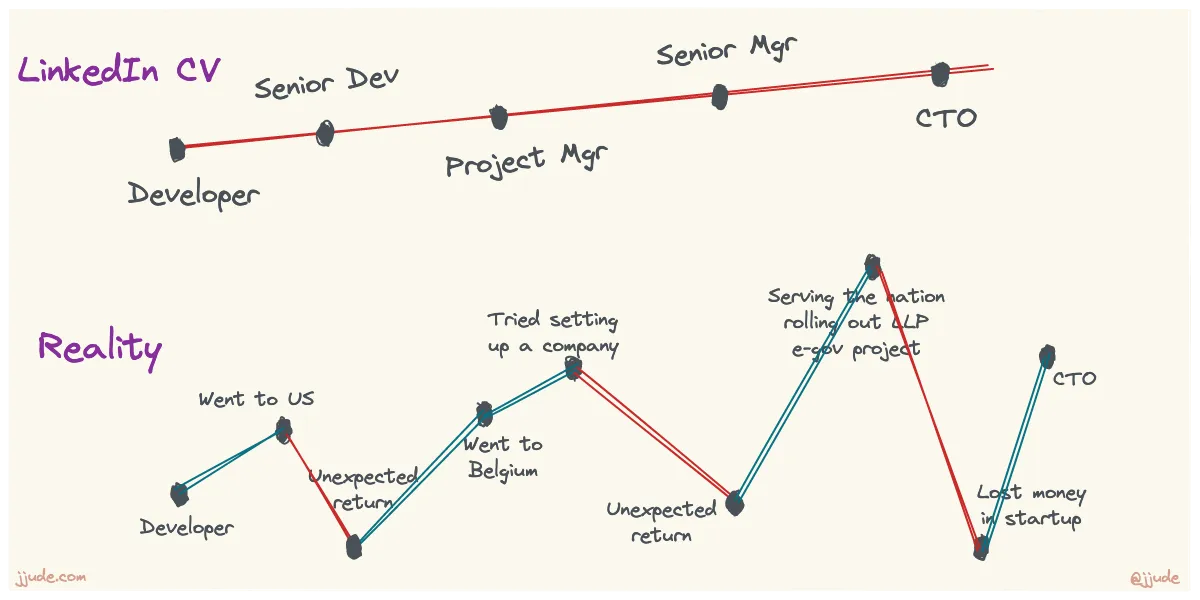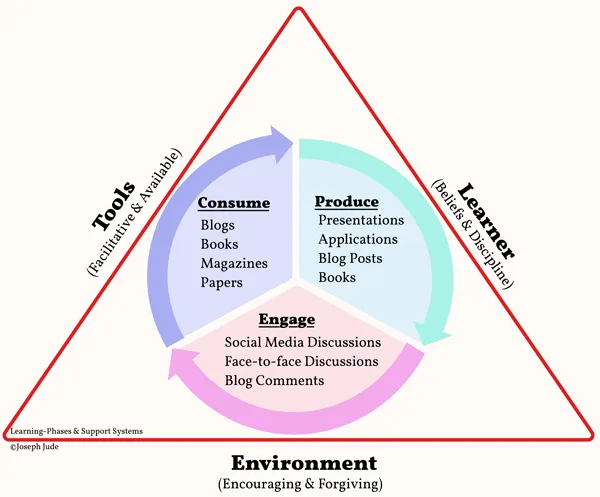Careers Aren’t Straight Lines. They Squiggle and Stumble Toward Success
Career pivots aren't setbacks they're steps to success. Here's how career zigzags shaped my growth
I've changed careers more times than I can count.
I started out as a videographer and editor, then taught software programming at a local computer training center, tried my hand as an independent consultant, later joined as a corporate employee, spent time advising the government, launched a startup that didn’t take off and today, I work as a CTO.
I’ve worked in small companies and large ones. In India and Europe.
At the time, it looked messy.
Honestly, it was messy.
But now, looking back over 30 years, I see how each squiggle added a new layer of depth. It’s made me who I am and I wouldn't trade that for anything.

Here’s why you should consider a career pivot, and how to do it well.
# Why You Should Pivot
When I say “career pivot,” I mean any kind of switch—across domains, job types, income models.
It could be:
- From tech to marketing
- From full-time to freelance
- From India to Europe,
- From Public to private
I pivoted almost every 5 years. Each time, I started with a beginner’s mind.
New team.
New domain.
New city.
That kept me sharp and hungry.
But the real payoff came later. Much later.
When I became a CTO, I could sit in strategy meetings, sales calls, or internal change programs and bring in insights drawing from all those different experiences.
I could connect dots that others missed.
That made me a valuable contributor. And that value gave me leverage:
- I now work just three days a week.
- I homeschool my kids.
- I earn well and choose the kind of work I want to do.
I get invited to speak at universities, colleges, and associations like TiE.
All of that gives me not just income but respect, freedom, and purpose.
# How to Pivot Well
A successful pivot isn’t luck. There’s a pattern to it.
Here’s what worked for me.
# 1. Find a Mentor (or Let One Find You)
I never went “mentor hunting.” But I stayed open and when the right people showed up, I followed their lead.
Dr. P.V. Rao was my first. A heart surgeon trained in England.
I was computerizing the cardiac surgery unit at Apollo Hospitals—completely out of my depth.
He took me under his wing. Taught me about the heart. About systems. About life.
Later, I met Shastri. Another mentor. But more than that—he became a role model.
He had done marketing. Sales. Entrepreneurship. Government consulting.
Most of my career pivots trace back to him.
The big lesson:
When you find someone with high standards and moral integrity, do everything you can to learn from them.
Walk with them. Work for them. Let them shape you.
# 2. Be Willing to Do the Grunt Work
Mentors give you access. But you still have to earn it.
At Apollo, Dr. Rao would explain a few concepts, then ask me to dig deeper.
So I’d go to the hospital library. Sit down with books I barely understood.
I’d study diagrams of valves and ventricles. I was an engineer, not a doctor but I learned.
Same when I became a business analyst.
I picked up books, read them, and tried everything I learned.
When I got into consulting, I studied Alan Weiss.
Page by page. Blogpost by post.
That’s how you earn credibility—and grow.
# 3. Build a Learning Framework
When I started out, there was no YouTube or Coursera.
So I relied on libraries—British Council, office libraries—and I bought books.
I spent on courses. Internet cafes. Forums. Whatever I could afford.
Over time, I built my own learning system:
Consume → Produce → Engage

I’d read a book, or study a concept.
Then write a blog post or create a slide deck.
Then share it. Ask for feedback. Learn from the responses.
That’s how I grew.
Not just by reading but by testing what I learned.
# 4. Adopt a “What If It Works?” Mindset
Most people ask: What if it doesn’t work?
That’s the wrong question.
A better one is: What if it works?
Every career shift involves some risk. But if the upside is big and the downside is manageable, it’s worth it.
When I got a government consulting offer in Delhi, I was in Bangalore.
I didn’t know Hindi. I’d never worked in government. And the contract was only for six months.
But the upside?
I’d get to work on national projects.
The downside? I’d have to find another job after six months.
I took it.
I ended up working there for six and a half years. It became one of the most fulfilling phases of my career.
Later, I launched a startup. I lost money. It didn’t take off.
But the downside was known. And the upside was worth the shot.
So I took it—and I gained perspective, even if I didn’t gain profit.
Always ask: What if it works?
If the downside is protected and the upside is real, go for it.
# Final Thought
Career pivots are not clean.
They’re not linear.
They won’t always make sense to others or even to you at the time.
But if you do them right, with the right mentors, the right work ethic, and the right mindset, they can lead to a richer, freer, and more meaningful life.
So don’t be afraid to pivot.
It might just be the smartest move you make.
Thanks to Krishna Kumar for the LinkedIn post that inspired this post and for reading its draft.
Under: #coach , #career , #visual